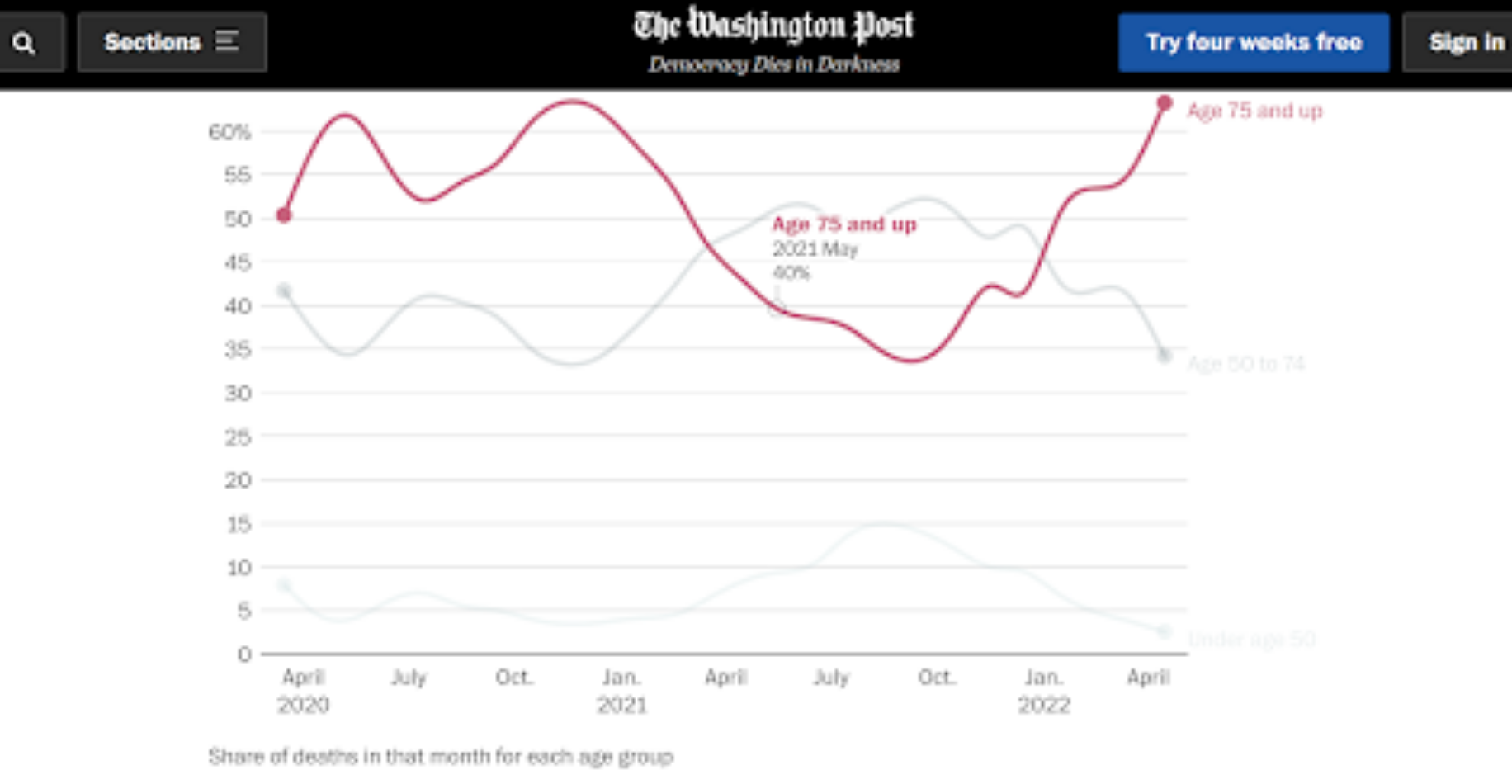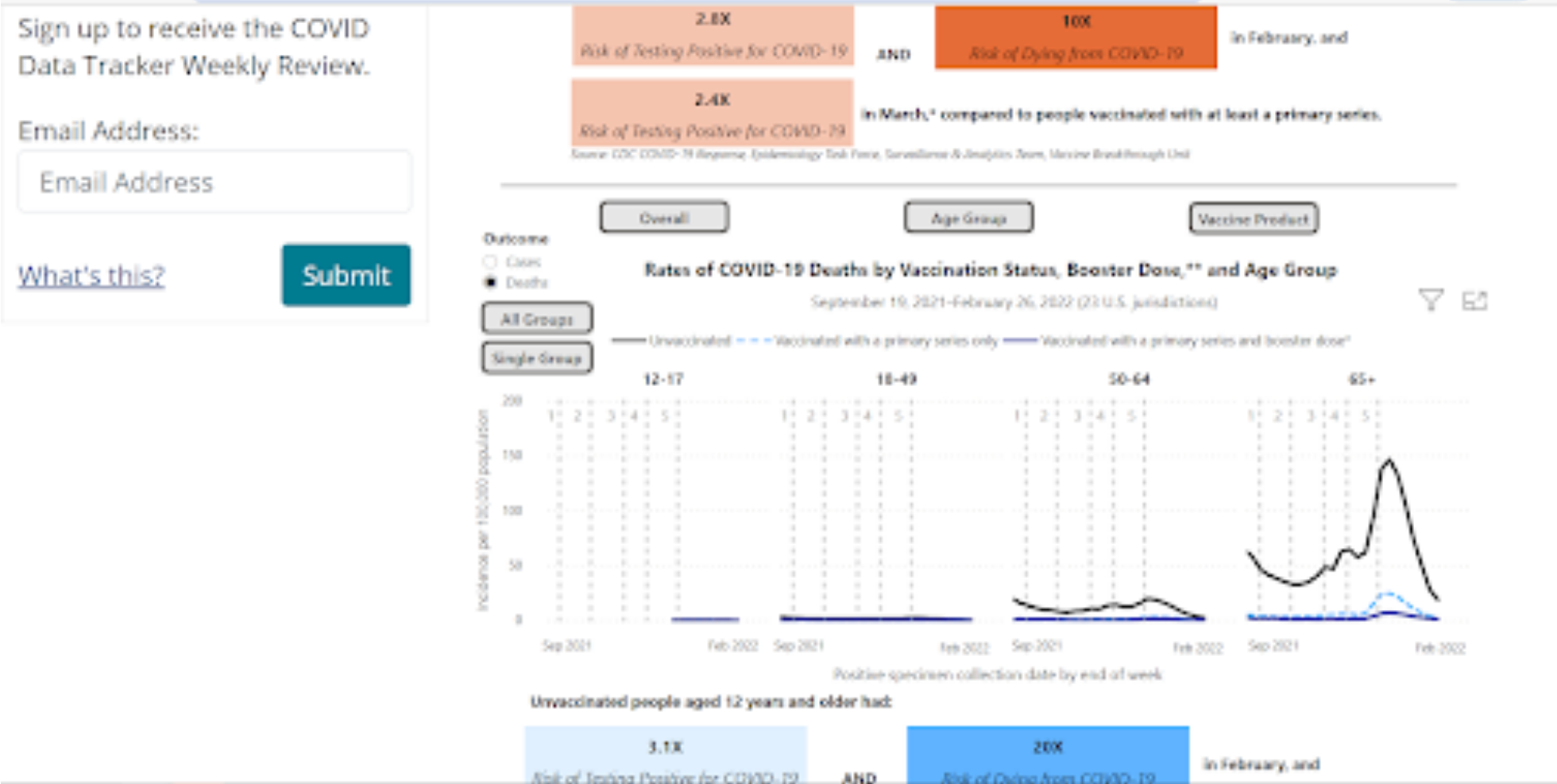Since the beginning of the pandemic, many commentators have identified the elderly as the group most vulnerable to COVID-19. I call a mistaken, targeted focus and overemphasis on any population group “pariahtization.” As recent evidence demonstrates, this "pariah-tized” focus on the elderly regarding COVID-19 is certainly misplaced. It also has resulted in untoward policies that caused more deaths in both the younger segments of the population (1), as well as the elderly (2).
True, more older people have died from COVID than younger people, but then again, more older people die from everything than younger people. Moreover, the elderly are not at greater risk of contracting COVID, either compared to other diseases, or even compared to young people (3), as even early statistics re-evaluating Chinese data demonstrated.

Contrary to popular opinion, then, COVID is not a disease of the elderly—like dementia, or cataracts, or osteoarthritis. Indeed, older people are less likely to die of COVID than heart disease or cancer. This is not so for the younger cohort, for whom during several months last year COVID was the leading cause of death.
For six months of 2021—half the year, COVID was the leading cause of death in those 45-54. In three months of the year, COVID was the leading cause of deaths for ages 55-64, but only in two months was it the leading cause of death for those 65-74, the same as for those 35-44; and only in one month was COVID the leading cause of death for those over 75. [3]

[3) Jared Ortaliza, et al. COVID-19 leading cause of death ranking, KFF, March 24, 2022
“Although COVID-19 death rates decreased for persons aged ≥85 years, age groups <75 years saw large increases from 2020 to 2021.” (4)
This misplaced focus on the aged being especially vulnerable has led younger people to unwisely eschew vaccination on the grounds that the disease is not dangerous to them.

Blame the Elderly
Now, the media, perhaps unintentionally, is leading an initiative to undermine the efficacy of vaccination in the elderly. This false narrative is based on early reports that COVID vaccine effectiveness waned in the elderly. Without looking deeper, many simply attributed this result to naturally occurring loss of immune function (4). Eventually, experts realized that waning COVID immunity in the elderly was due to the fact that they were vaccinated months earlier than younger folks and, as we know now, overall vaccine efficacy wanes over time— in everyone. Hence, the finding of waning immunity simply manifested in the older cohort first.
The Self-Fulfilling Prophecy of Junk Science
The attack on the elderly continues. A short May 3 Washington Post article reported that 42% of COVID deaths during January and February were in persons previously vaccinated, and then blamed this finding on the elderly:
“A key explanation for the rise in deaths among the vaccinated is that covid-19 fatalities are again concentrated in the elderly who are overwhelmingly immunized … but vaccines are less effective and their potency wanes over time in older age groups.”
— The Washington Post
No data was given in support. However, several links were provided, including one to a “study” done by none other than—the Washington Post. That “study” was the Post’s self-reported analysis of CDC data, and which, as is de rigueur for peer-reviewed studies, (sarcasm here) was short on data, but replete with human-interest stories.
Again, like traditional peer-reviewed and even pre-print research (more sarcasm here), the conclusion was reported before the methodology, which the authors provided at the end, along with a link to partial data. The ‘unbiased’ headline summed it up: “Covid deaths no longer overwhelmingly among the unvaccinated as toll on the elderly grows,” insinuating that the increased death rates were to be found mostly in the elderly— vaccinated or not.
The Post article horribly mangled and co-mingled data, reporting vaccination status, death, and age, and used the statistically validated rule (again sarcasm, please) that correlation equals causation to reach its conclusion. Actually, the Post “report” linked to yet another Post article which contradicted the first, reporting that vaccine effectiveness declined in everyone. This article cited three studies published in the CDC’s Morbidity and Mortality Weekly Report (MMWR), confirmed by yet another study published in The Lancet. The Post “study” drew the conclusion from three boot-strapped claims: Here are the first two:
● “Nearly two-thirds of the people who died in the omicron surge were 75 and older, according to a Post analysis,” and
● “Seniors are overwhelmingly immunized but vaccines are less effective and their potency wanes over time in older age groups.”
It is true that one study did report a correlation between waning effectiveness and age, the second predicate. However, that study used an age cutoff of 55—so it’s not clear how the Post compared that with excess deaths in the 75 and older group. It is also unknown whether the excess deaths in the 75 and older group were part of the “overwhelmingly” vaccinated group.
The Post study then added a third claim to their set of givens:
● In the third wave of the Delta epidemic, one-third of deaths were in those over 75.
Again, we have no idea how many of this group were vaccinated or boosted. And, of course, during the Delta epidemic, the proximity of vaccination to onset of disease was far shorter than during the Omicron wave. Hence at that point in time, one would expect that, comparatively speaking, the older (mostly vaccinated cohort) would enjoy greater protection compared to a younger (mostly unvaccinated) cohort.
The key point, of course, is that the populations compared in the Post study are not comparable. Here’s another graph on which the “study” predicated its claims:

Indeed, this graph shows that more deaths in April 2022 were in those aged 75 and older. What we do not know from this image is what percentage of each age group was vaccinated and boosted, and whether those vaccines were administered more than five to eight months prior, by which point the vaccine’s effectiveness would have waned in everyone.
From April to October 2021, Age was Protective Against COVID
The graph also indicates there was a higher percentage of deaths in those between 50 and 74 than in those over 75. This suggests that older age is actually protective against COVID—or that vaccinating this group conferred the protection, and that older age did not contribute to the death rate.
One also must wonder whether the number of deaths evaluated by the Post presents a robust enough sample from which to draw valid conclusions. According to the data graphically presented, the number of cases evaluated claim a 34 per million death rate for the unvaccinated, compared to 2 per million for the vaccinated—of which some unknown portion is over 75.
Below is another graph from the Post “study,” from the CDC website, to support the paper’s conclusion that the share of deaths among the vaccinated has risen. There is no indication of age, however. So, while there is an increase in deaths in the vaccinated and boosted, from this graph, we don’t know in which age category they fall.

Helpfully, the CDC website does break down this graph by age—an analysis conspicuously missing from the Post “study.” The age demarcation used by the CDC is 65, not 75, the age on which the Post “study” based its initial claim that twice as many vaccinated elderly are dying from Omicron vs. Delta.

From the CDC data, we see a small spike in the 50-64 cohort, and a greater increase in those over 65. But, again, these numbers are very small.
Christmas Presents
Of perhaps the greatest significance is that spikes occurred during Christmas 2021 (period 4), where those over 65 suffered a small uptick in deaths, even in the boosted group, although by February the numbers reverted to nil. From this graph it is impossible to determine if that uptick was statistically significant.
The timing of the spike, however, suggests a temporal secular trend—meaning, something extrinsic to age and vaccination may have accounted for the excess deaths. And that may have been Christmas.
It is well-known that heart attacks and elderly deaths spike during the Christmas period. Even the Washington Post knows that. Some of these deaths are cardiac related, which, decidedly, is influenced by age. The other apparent reason for the normal Christmas spike is delayed medical treatment due to holiday pressures and diversions.
This factor might have influenced excess elderly COVID deaths, especially among the vaccinated and boosted, as this group, believing they are well-protected, may have deferred treatment, as the human interest stories appended to the Washington Post “study” attested, and it was the delay that resulted in the uptick.
Boosting Works
We also need to recall that waning vaccination in the elderly is amply addressed by boosting. A very large and well-conducted study recently demonstrated that boosting restores vaccine efficacy—even in the elderly.

Figure 2: Effectiveness against infection of homologous and heterologous booster doses in individuals aged 55 years or older
(BNT162b2 = Pfizer; ChADOx1 = Oxford/AstraZenec; mRNA-1273 = moderna). (3)
These results were confirmed in other studies, with an Israeli study documenting the significant effects of boosting in those over 60, both for Delta and Omicron.
It may well be that during the Omicron surge twice as many people 75 and older died from COVID-19 compared to Delta. The question that remains unanswered from this expose is: were the groups boosted? Indeed, were they even vaccinated? The Post “study” doesn’t tell us.
The Take-Home Message:
● Boosters help mitigate severe COVID disease and death—even in the elderly, even for Omicron.
● You can’t pick and choose your statistics, even to vilify the elderly.
● The Washington Post had best stick to reporting, and avoid venturing into epidemiological or statistical analysis.
(1) Barbara Pfeffer Billauer SSRN.com 4109051 Discrimination Today - The Dangers of Pariah-tizing the Elderly During the COVID Pandemic
(2) Kathy Cerminara, et al.,Using Therapeutic Jurisprudence to Improve Nursing Home Regulation During Future Pandemics, Nova Law Review, forthcoming. Nova Law Review, Vol. 46, No. 3, 2022
(3) Katie Shepherd, The Latest, Corona Virus Updates, Washington Post, May 3, 2022
(4) MMWR. Weekly / April 29, 2022 / 71(17);597-600
(5) The graph shows the efficacy of three primary vaccines through the Delta surge. Comparing primary doses using the Pfizer vaccines and Oxford- Astra Zeneca, the effectiveness registered 92.5% and 95.3%, respectively, (for Pfizer) and 89% and 91% for (Oxford-Astra Zeneca) as a primary dose followed by boosters of Pfizer and Moderna, respectively. When no booster was administered, the effectiveness was 85.3% where Pfizer was the initial dose, and 71% where Oxford/Astra-Zeneca was the primary vaccine.
(6) This feature has been compensated in flu, for example, by providing the elderly with higher dose vaccines. An effect is confirmed by the longer efficacy of Moderna’s vaccine, which is a higher dose than Pfizer’s.
JP article (*) This constitutes a 53% increase in the number of serious cases under the age of 60 in the last month.




